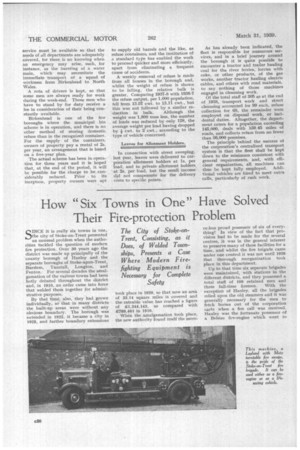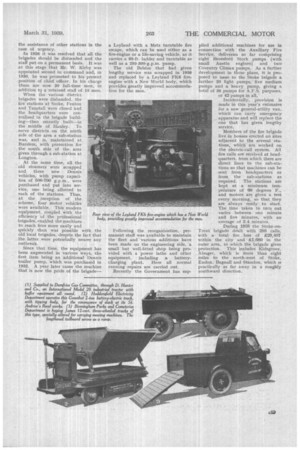How "Six Towns in One" Have Solved Their Fire-protection Problem
Page 92

Page 93

If you've noticed an error in this article please click here to report it so we can fix it.
The City of Stoke-onTrent, Consisting, as it Does, of Welded Townships, Presents a Case Where Modern Firefighting Equipment is Necessary for Complete Safety
SINCE it is really six towns in one, the city of Stoke-on-Trent presented an unusual problem when the authorities tackled the question of modern fire protection. Over 30 years ago the district was made up principally of the 'county borough of Hanley and the separate boroughs of Stoke-upon-Trent, Burslem, Tunstall, Longton, and Fenton. For several decades the amalgama ti o n of the various towns had been hotly debated throughout the district and, in 1910, an order came into force that welded them together for administrative purposes.
By that time, also, they had grown so that in many districts the built-up areas were without any obvious boundary. The borough was extended in 1922, it became a city in 1925, and further boundary extensions
took place in 1929, so that now an area of 33.14 square miles is covered and the rateable value has reached a figure of £1,244,143, as compared with £789,461 in 1910.
When the amalgamation took place, the new authority found itself the more
or-less proud possessor of six of everything! In view of the fact that provision had to be made for the several centres, it was in the general interest to preserve many of these facilities for a time, and whilst the fire brigade came under one control it was not until 1926 that thorough reorganization took place in this department.
Up to that time six separate brigades were maintained, with stations in the different districts, and they possessed a total staff of 100 retained men and three full-time firemen. With the exception of Hanley, all the brigades relied upon the old steamers and it was generally necessary for the men to fetch horses out of the corporation carts when a fire call was received. Hanley was the fortunate possessor of a Belsize fire-engine which went to
the assistance of other stations in the case of urgency.
In 1926 it was resolved that all the brigades should be disbanded and the staff put on a permanent basis. It was at this stage that Mr. W. Kirby was appointed second in command and, in 1930, he was promoted to his present position of chief officer. In his charge there are now 30 full-time men, in addition to a retained staff of 15 men.
When the various district brigades were disbanded, the fire stations at Stoke, Fenton and Tuns-tall were closed and the headquarters were centralized in the brigade building—then recently built—in the middle of Hanley. To serve districts on the north side of the area a sub-station was, and is, maintained at Burslem, with protection for the south side of the. area given through a sub-station at Longton.
At the same time, all the old steamers were scrapped and three new Dennis vehicles, with pump capacities of 500-700 g.p.m., were purchased and put into service, one being allotted to each of the stations. Thus, at the inception of the scheme, four motor vehicles were available. This modern equipment, coupled with the efficiency of the professional brigades, enabled the machines to reach fires more easily and quickly than was possible with the old local brigades, despite the fact that the latter were potentially nearer any outbreak.
Since that time, the equipment has been augmented in various ways, the first item being an additional Dennis trailer pump, Which was purchased in 1932. A year later came the machine that is now the pride of the brigade—
a Leyland with a Metz turntable fire escape, which can be used either as a fire-engine or a life-saving vehicle, as it carries a 90-ft. ladder and turntable as well as a 250-300-g.p.m. pump.
The old Belsize that had given lengthy service was scrapped in 1936 and replaced by a Leyland FK6 fire. engine with a New World body, which provides greatly improved accommodation for the men.
Following the reorganization, permanent staff was available to maintain the fleet and various additions have been made on the engineering side, 'a small but well-fitted shop being provided with a power lathe and other equipment, including a batterycharging plant. Here all normal running repairs are carried out.
Recently the Government has sup plied additional machines for use in connection with the Auxiliary Fire Service, deliveries so far comprising eight Eieresford Stork pumps (with small Austin engines) and two Coventry Climax pumps. As a further development in these plans, it is proposed to issue to the Stoke brigade a further 20 light pumps, five medium pumps and a heavy pump, giving a total of 36 pumps for A.F.S. purposes, or 42 pumps in all. Incidentally, provision is made in this year's estimates for a new general-utility van, which can carry emergency apparatus and will replace the one that has given lengthy service.
Members of the fire brigade live in houses erected on sites adjacent to the several stations, which are worked on the electric-call system. All fre calls are received at headquarters, from which there are direct lines to the sub-stations so that machines can be
• sent from headquarters or from the sub-stations as required. The stations are kept at a minimum temperature of 00 degrees F., and motors are given a test every morning: so that they are always ready to start. The time taken to turn out• varies between one minute and five minutes, with an average of 2.4 minutes.
During 1938 the Stoke-onTrent brigade dealt with 288 calls, with a total fire loss of £29,487 within the city and £1,1380 in the outer area, to which the brigade gives protection. This includes Kidsgrove, Alsager, which is more than eight miles to the north-west of Stoke, Endon, Bagnall and Standon. which is practically as far away in a roughly southward direction.
























































































































































